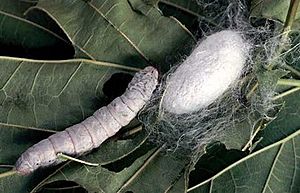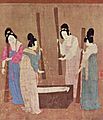Sericulture facts for kids
Sericulture, also called silk farming, is the process of making silk fibers. It starts by raising silkworms and then processing the fibers they produce. Silk fibers are combined into silk thread. The thread can then be twisted into silk yarn or woven into silk cloth (fabric).
Production
Stages of production
The stages of production are as follows:
- The silk moth lays thousands of eggs.
- The silk moth eggs hatch to form larvae or caterpillars, known as silkworms.
- The larvae feed on mulberry leaves.
- Having grown and moulted several times, the silkworm pushes out silk fibers to make a net to hold itself.
- It swings its head from side to side in a figure '8' distributing the saliva that will form silk.
- The silk solidifies when it contacts the air.
- The silkworm spins approximately one mile of filament (fiber) and completely encloses itself in a cocoon. This takes about two or three days.
- The whole cocoons are picked and boiled, killing the silkworm pupa.
- The silk is obtained by brushing the undamaged cocoon to find the outside end of the filament.
- The silk filaments are then wound on a reel.
The amount of usable quality silk in each cocoon is small. As a result, about 2500 silkworms are required to produce a pound of raw silk.
One cocoon contains approximately 1,000 yards (meters) of silk filament. The silk at the winding stage is known as "raw" silk. One thread is made up of as many as 48 individual silk filaments.
Images for kids
-
Court Ladies Preparing Newly Woven Silk by Emperor Huizong of Song
See also
 In Spanish: Sericicultura para niños
In Spanish: Sericicultura para niños

All content from Kiddle encyclopedia articles (including the article images and facts) can be freely used under Attribution-ShareAlike license, unless stated otherwise. Cite this article:
Sericulture Facts for Kids. Kiddle Encyclopedia.












